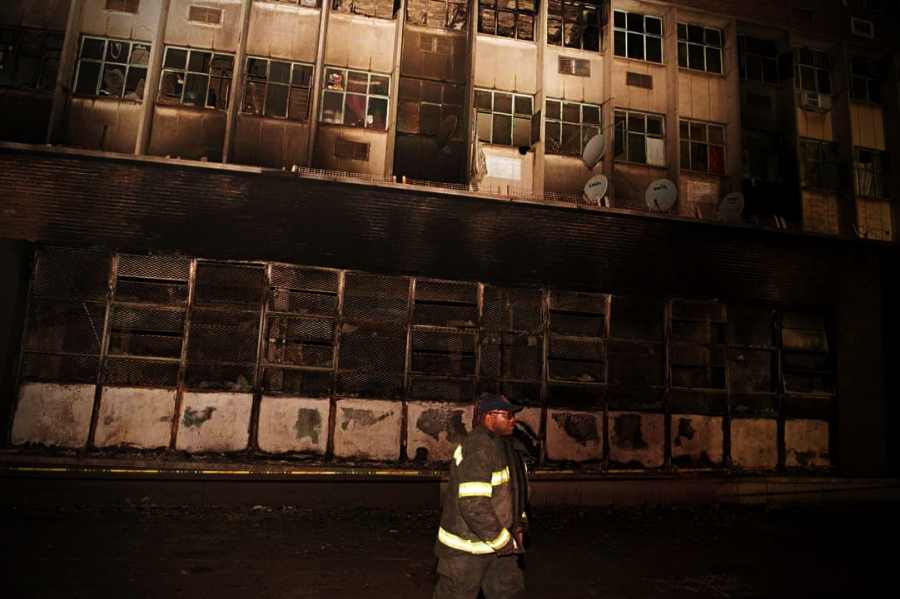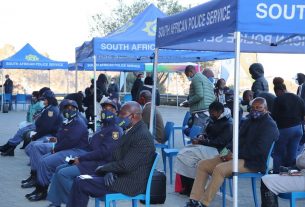Sun 03 September 2023:
The fire that killed at least 76 people in a five storey building in Johannesburg on 31 August is not an isolated incident, and has elicited the usual unhelpful response from some city officials and politicians.
They have placed the blame on the informal occupation of abandoned buildings, a phenomenon known as “hijacking”. They have also blamed immigrant populations who, they say, are the primary residents of such buildings. To solve the problem, they argue, hijacked buildings should be expropriated and redeveloped by the private sector.
A politician in the city council has also called for “mass deportations” of “illegal foreigners”.
Based on my work as a researcher on how cities are built and transform at the Gauteng City-Region Observatory (GCRO), I argue that all of this is a distraction from the urgent work of reducing risks in the living environments of the poor, and reducing the risk of fire more generally. The observatory, a partnership between the Gauteng provincial government, the universities of the Witwatersrand and Johannesburg, and the South African Local Government Association, builds the data and analysis to help inform development in the Gauteng City-Region.
The rhetoric by politicians and city officials treats the latest tragedy as a freakish problem of hijacked buildings occupied by migrant populations. Yet as human geographer Nigel Clark sadly notes, it is important to acknowledge the way in which catastrophes are a normal part of life – particularly for vulnerable groups – rather than exceptional or unusual events.
In Johannesburg, fires are not limited to “hijacked” buildings. They have also occurred in legally occupied buildings. Furthermore, fires are not a specific risk to inner city populations. They are a regular occurrence in shack settlements across the city. The use of this tragedy by some politicians to argue in favour of removing hijacked buildings is part of a longstanding pattern of blaming the poor for the conditions and justifying further suffering that they wish to heap on them.
JOBURG FIRE: AUTHORITIES WILL CONDUCT DNA TESTS ON “BODIES THAT BEEN BURNT BEYOND RECOGNITION”
A pervasive problem
There is no doubt that unscrupulous or negligent informal landlords bear much responsibility for failing to ensure basic fire safety. Yet this problem is not limited to hijacked buildings.
In 2018, emergency services were unable to contain a fire at the Bank of Lisbon Building in downtown Johannesburg because there was insufficient water pressure in the building and no fire suppression systems had been installed.
Three firefighters died, and the building itself was subsequently demolished. The building had not been illegally occupied; it was rented by the Gauteng provincial government, which was aware that the building was non-compliant in advance of the incident.
Three years later, emergency services were hampered in their efforts to contain the fire at a public hospital, Charlotte Maxeke, by incompatible fire hydrant couplings. As these cases show, eradicating “hijacked” buildings would not have solved failures to comply with fire regulations in legally occupied buildings in the city.
Nor would eradicating “hijacked” buildings remove the risk of fire posed to low income groups across the city as a whole. In Johannesburg more than one in ten households lives in an informal dwelling outside the city centre, either in shack settlements or in back yards. This is calculated from the Gauteng City-Region Observatory’s Quality of Life 6 survey 2020/21.
These kinds of settlements are also prone to fires as a result of the materials used to construct dwellings, the density of settlements and the risky sources of energy for heating, cooking and light.
Once again, some politicians and officials have arrived at the idea that since these settlements are not fit for human habitation, they should be eliminated. In 2006 the elected representative responsible for housing in the KwaZulu-Natal province announced legislation
to provide for the progressive elimination of slums.
It would have forced private land owners to evict shack dwellers. But the shack dwellers movement Abahlali Basemjondolo successfully challenged this initiative in the Constitutional Court.
Disposable lives
According to the geographer Martin Murray, shack fires underscore the disposability of the lives of the poor. South Africa’s acute levels of inequality and poverty mean that some people can afford to buy their way out of risks while others cannot.
Inner city occupations and shack settlements alike are the inevitable consequence of the fact that huge populations of people have to get by without a living wage. If these households earned higher wages, they would not choose to live in places that were at risk of fire, flooding and other potential disasters.
As with the push to evict shack dwellers, the impulse to evict the residents of hijacked buildings conflates unsafe living conditions with those who live in them. A similar conflation occurs on the imagined solution: eradicating the problem means eradicating communities of people in which the problem manifests. In other words, the language of eradication blames the victims of social inequality for their own suffering, and sets the stage for exposing them to further risk.
Helping without eradicating
Cyril Ramaphosa, South Africa’s president, stated that the fire was a wake up call for the government to provide habitable housing. Government does indeed have a vital role to play in promoting the right to decent housing for all. It needs to do so in a way that takes into account the full complexity of the structural conditions at play, providing giveaway housing, or working with other stakeholders to correct for failings in the housing market that leave poor and working class people without affordable options.
A good example is the City of Johannesburg’s recent inclusionary housing policy that obliges developers to include affordable housing in all projects. Much more should be done by the state to provide housing.
Yet informal settlements and illegal occupations of inner city buildings will not be eradicated – no matter how many houses the state builds – as long as acute levels of unemployment and poverty continue. Rather than abandoning residents of such places until they can be formally accommodated, or rendering them homeless through eviction, they need to be supported where they live or provided with alternative accommodation.
The living environments of the poor can be made less risky. The epidemic of shack fires can be reduced with fire breaks and fire fighting infrastructure. Similarly, the risk of fire in inner city buildings can be reduced by enforcing tried and tested fire regulations: ensuring that fire escapes and fire fighting infrastructure are functional. Authorities should compel landlords – whether informal or formal – to implement them.
These and many other measures – rather than the impulse to “eradicate” – are the basis through which society cares for vulnerable people.
The statements, views and opinions expressed in this column are solely those of the author and do not necessarily represent those of Independent Press.
Author:
![]()
Richard Ballard
Chief Researcher: Gauteng City-Region Observatory, Wits University and University of Johannesburg, University of the Witwatersrand
Richard Ballard trained in the field of geography at the University of KwaZulu-Natal and the University of Wales, Swansea.
One of his research themes is on the relationship between the ideals of spatial transformation and real world processes that produce urban space. Under this theme he has published on attempts by developers to secure permission to build major projects; the policy turn to mega projects within the public housing sector; the role of construction labour in producing walled suburbs and the production of space in Gauteng Province.
A second area of interest is the way in which residents of South Africa’s cities form identities in relation to the places where they live and the people who share these spaces. Publications on this theme are on white responses to urban desegregation, gated communities, the place of plants and animals in cities, social cohesion and changing scales of identification.
A third area of interest is urban governance and politics, with publications on local government elections, participatory governance processes, social movements and everyday resistance.
Recent publications
Ballard, R., and Barnett, C. (eds) (2023). The Routledge Handbook of Social Change. Abingdon: Routledge.
Ballard, R., and Barnett, C. (2023). ‘Apprehensions of Social Change’. In Richard Ballard and Clive Barnett (eds) The Routledge Handbook of Social Change. Abingdon: Routledge, pp. 1-16.
Ballard, R. (2023). ‘Everyday resistance: theorising ow the “weak” change the world’. In Richard Ballard and Clive Barnett (eds) The Routledge Handbook of Social Change. Abingdon: Routledge, pp. 303-314.
Ballard, R., and Mapukata, C. (2022). South African Urban Imaginaries. GCRO Research Report 13. Johannesburg: Gauteng City-Region Observatory.
Ballard, R., Butcher, S., Joseph, K., de Kadt, J., Hamann, C., Mapukata, S., Mkhize, T., Mosiane, N., Parker, A., and Spiropoulos, L. (2021). ‘Scale of Belonging: Gauteng 30 Years After the Repeal of the Group Areas Act’. Urban Forum. 32(2), pp. 131-139.
Ballard, R., Jones, G.A., and Ngwenya, M. (2021). ‘Trickle-out urbanism: Are Johannesburg’s gated communities good for their poor neighbours?’ Urban Forum. 32(2), pp. 165-182.
Ballard, R., Hamann. C., and Mkhize., T. (2021). ‘Johannesburg: Repetitions and Disruptions of Spatial Patterns’. In Lemon, A., Donaldson, R. and Visser, G. (eds) South African urban change three decades after apartheid: Homes Still Apart? Cham, Switzerland: Springer, pp. 33-55.
Ballard, R., and Hamann, C. (2021). ‘Socio-Economic Segregation and Income Inequality in the City of Johannesburg’. In Maarten van Ham, Tiit Tammaru, Ruta Ubarevičienė and Heleen Janssen (eds) Urban Socio-Economic Segregation and Income Inequality. Cham, Switzerland: Springer. pp. 91-109.
Ballard, R., Hamann, C., and Mosiane, N. (2021) Spatial Trends in Gauteng. GCRO Occasional Paper 19.
Ballard, R., and Butcher, S. (2020). ‘Comparing the relational work of developers’. Editorial. Environment and Planning A: Economy and Space. 52(2), pp. 266-276.
Ballard, R., and Harrison, P. (2020). ‘Transnational Urbanism Interrupted: A Chinese developer’s attempts to secure approval to build the “New York of Africa” at Modderfontein, Johannesburg’. Environment and Planning A: Economy and Space. 52(2), pp. 383-402.
Ballard, R., (ed) (2019) Social Cohesion in Gauteng. GCRO Research Report # No 10. Johannesburg: Gauteng City-Region Observatory.
Ballard, R. and Harrison, P. (2019). ‘Transnational urbanism interrupted: A Chinese developer’s attempts to secure approval to build the ‘New York of Africa’ at Modderfontein, Johannesburg.’ Environment and Planning A. 52(2).
Ballard, R., Dittgen, R., Harrison, P. and Todes, A. (2017). ‘Megaprojects and urban visions: Johannesburg’s Corridors of Freedom and Modderfontein’. Transformation. 95.
Ballard, R. and Rubin, M. (2017). ‘A “Marshall Plan” for human settlements: how megaprojects became South Africa’s housing policy’. Transformation. 95.
Ballard, R. (2017). ‘Prefix as policy: megaprojects as South Africa’s big idea for human settlements’. Transformation. 95.
Ballard, R. (2017). ‘Governance and development’. In Douglas Richardson, Noel Castree, Michael F. Goodchild, Audrey L. Kobayashi, Weidong Liu Richard Marston (eds.) The International Encyclopaedia of Geography: People, the Earth, Environment, and Technology. London: Wiley-Blackwell.
Ballard, R. (2016). ‘Whiteness and the end of apartheid – Review of Falkof, Nicky (2015) Satanism and Family Murder in Late Apartheid South Africa: Imagining the End of Whiteness. Houndmills: Palgrave Macmillan’. Journal of Southern African Studies. 42(5), 1021-1022.
Ballard, R., Nel, W., Hill, T. and Maharaj, B. (2016). ‘South African Geography at 100’. South African Geographical Journal. 98(3), 403-404.
Ballard, R. (2016). Review of Daniel Conway and Pauline Leonard (2014). ‘Migration, space and transnational identities: the British in South Africa’, Ethnic and Racial Studies. 39(13), pp. 2427-2429.
Ballard, R. (2016). ‘Community and the balkanization of social membership’. Dialogues in Human Geography. 6(1), pp. 78–81
Ballard, R. (2015). ‘Geographies of development III: militancy, insurgency, encroachment, and development by the poor’. Progress in Human Geography. 39(2), pp. 214–224
______________________________________________________________
FOLLOW INDEPENDENT PRESS:
TWITTER (CLICK HERE)
https://twitter.com/IpIndependent
FACEBOOK (CLICK HERE)
https://web.facebook.com/ipindependent
Think your friends would be interested? Share this story!





